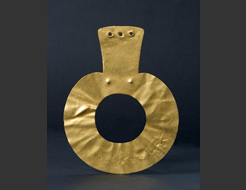|
||||||||||||||||||||||||||||||||
|
|
Museum of: Athens | |||||||||||||||||||||||||||||||
| Name of the artefact: Ring shaped amulet | ||||||||||||||||||||||||||||||||
|
Gold ring-shaped amulet of hammered sheet depicting a
very schematised female figure. It is the largest of its type found so far
on Greek soil. Possibly it is one of the largest ever found in the Balkans
and Anatolia. This object together with other 69 objects constitute a
‘treasure’, the so-called Neolithc Treasure of the National Archaelogical
Museum of Greece. |
||||||||||||||||||||||||||||||||
|
WHERE IS IT AND MAIN
CHARACTERISTICS |
STATE |
|||||||||||||||||||||||||||||||
|
Department: |
Prehistoric |
Preservation: |
Very good | |||||||||||||||||||||||||||||
|
Inventory number: |
16640 |
Restauration: |
No restored | |||||||||||||||||||||||||||||
|
Name of the artefact: |
Ring shaped amulet |
Completeness: |
Complete | |||||||||||||||||||||||||||||
|
Object type: |
Amulet |
|||||||||||||||||||||||||||||||
|
Material: |
Gold |
|||||||||||||||||||||||||||||||
|
Methof of manufacture: |
Hammered |
|||||||||||||||||||||||||||||||
|
Decoration
type: |
Excision |
|||||||||||||||||||||||||||||||
|
Distinctive mark: |
Large size |
|||||||||||||||||||||||||||||||
|
DIMENSIONS |
PERIOD OF USE |
|||||||||||||||||||||||||||||||
|
Length (mm): |
- |
Epoque: |
Neolithic |
|||||||||||||||||||||||||||||
|
Heigth
(mm): |
155 |
Culture: |
- |
|||||||||||||||||||||||||||||
|
Diameter
(mm): |
12 |
Period: |
Final Neolithic |
|||||||||||||||||||||||||||||
|
Width (mm): |
- |
Face: |
- |
|||||||||||||||||||||||||||||
|
Thickness (mm): |
- |
Absolute chronology: |
4500-3300BC |
|||||||||||||||||||||||||||||
|
Weight
(g): |
80.6 |
|||||||||||||||||||||||||||||||
DISCOVERY |
||||||||||||||||||||||||||||||||
|
Date: |
1997 |
Country: |
Greece |
|||||||||||||||||||||||||||||
|
District: |
Athens |
Town hall affiliation: |
- |
|||||||||||||||||||||||||||||
|
Village: |
- |
Discovery findspot: |
- |
|||||||||||||||||||||||||||||
|
Condition of discovery: |
Unknown |
Discovery type: |
Other |
|||||||||||||||||||||||||||||
|
ANALYSES – DETERMINATIONS |
FILLED IN BY |
|||||||||||||||||||||||||||||||
|
Type: |
Xray - Sem - Xrf |
Name: |
Alexandra Christopoulou |
|||||||||||||||||||||||||||||
|
Laboratory: |
Laboratories of Archaeometry and Material
Analysis |
Institution: |
National Archaeological Museum -
Greece |
|||||||||||||||||||||||||||||
|
No./Code: |
- |
Date: |
21/11/2005 |
|||||||||||||||||||||||||||||
|
DEEPENINGS |
||||||||||||||||||||||||||||||||
|
Morphology of the object: |
||||||||||||||||||||||||||||||||
|
Gold ring-shaped amulet of hammered sheet depicting a
very schematised female figure. It is the largest of its type to have been
found so far on Greek soil. Possibly it is one of the largest ever found
in the Balkans and Anatolia. The object has been modelled from a single
golden sheet. The central round core and the trapezoidal upper part were
cut off and leveled also by hammering. Then, the three holes for
suspention were opened with a sharp implement and the remaining gold from
this action was also hammered, creating thus the main and the back /
unvisible faces of the amulet (photo). This distinction was further
established by the formation of the two protrusions on the ring below the
trapezoidal stem. These were formed with a sharp tool by bitting (without
piercing through) from the back side. These protrusions indicate female
breasts, and in consequence the amulet represents a female figure in
absolute abstraction: the stem is the head with the neck and the ring is
the body of the woman. |
||||||||||||||||||||||||||||||||
|
Decoration: |
||||||||||||||||||||||||||||||||
|
- |
||||||||||||||||||||||||||||||||
|
Inscription: |
||||||||||||||||||||||||||||||||
|
- |
||||||||||||||||||||||||||||||||
|
Analogies: |
||||||||||||||||||||||||||||||||
|
- |
||||||||||||||||||||||||||||||||
|
Interpretation: |
||||||||||||||||||||||||||||||||
|
- |
||||||||||||||||||||||||||||||||
|
Bibliography: |
||||||||||||||||||||||||||||||||
|
- |
||||||||||||||||||||||||||||||||

